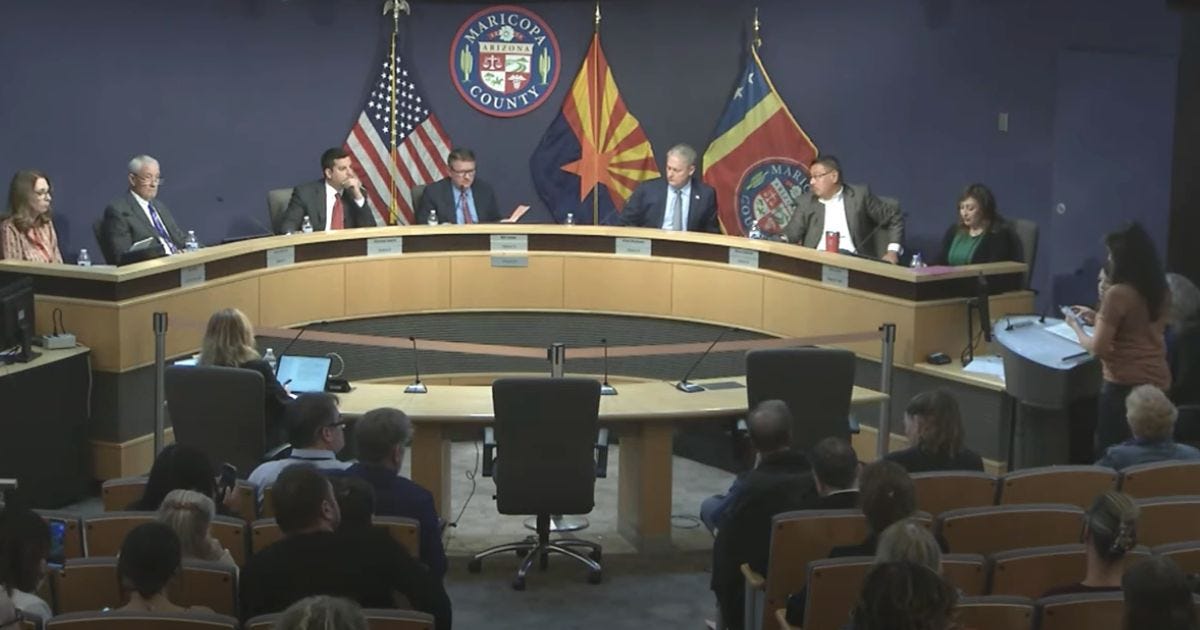Maricopa County response letter to Arizona Attorney General Jennifer Wright Nov. 27, 2022, Printing tabulating issues regrettable “But it did not violate the uniformity statutes”
Maricopa County response letter to Arizona Attorney General Jennifer Wright Nov. 27, 2022, Printing tabulating issues regrettable “But it did not violate the uniformity statutes”
“November 27, 2022
VIA EMAIL TO:
Jennifer Wright
Assistant Attorney General
2005 North Central Ave.
Phoenix, AZ 85004
jennifer.wright@azag.gov
RE: Response to your November 19, 2022 letter
Dear Ms. Wright:
Your November 19, 2022 letter requested information regarding the 2022 General Election. You also sought answers to several legal questions. This letter, which addresses your legal questions, and the Election Department’s Report (the “Report”), which is publicly available at https://elections.maricopa.gov/asset/jcr:d294ebcd-eb4d-4efc-83d7-bd85f2fd7f9d/2022.11.27- Final-Report-and-Exhibits, stands as the Maricopa County Board of Supervisors’ (the “County”) 1 continued commitment to operating elections transparently.2
A. The Meaning of the Requirement of Uniformity in Elections.
In footnote 1 to your letter, you state that “State and federal law require ‘uniform’ administration of elections.” The County’s technical, printer issues in some of its vote centers did not violate that requirement.
1. The Free and Equal Clause of the Arizona Constitution.
First, you cite to Article II, Section 21 of the Arizona Constitution to support your suggestion that the County’s printer difficulties, causing some voters to need to place their ballots into Door 3, violated the requirement for uniform and free elections. That constitutional provision requires that “[a]ll elections shall be free and equal, and no power, civil or military, shall at any time interfere to prevent the free exercise of the right of suffrage.” This constitutional guarantee means that the state of Arizona must provide for uniformity in elections across the state so that they will be free and equal for all the state’s voters. It does not mean that an election might be invalid if there are unexpected printing difficulties preventing on-site tabulation, when all the voters who attempted to vote were provided legal options for doing so.
Eight Arizona counties do not have any tabulators in their polling locations at all. In Apache, Coconino, Gila, Mohave, Pima, Pinal, Santa Cruz, and Yavapai counties, every Election Day voter places his or her ballot into a ballot box (much like Door 3). All those ballots are taken back to a central, election headquarters to be tabulated (just like Door 3 ballots are taken to the Maricopa County Tabulation and Election Center to be tabulated).
It cannot be the case that the limited use of the Door 3 ballot box for some voters in Maricopa County violates the Constitution, while the required use of a ballot box by every voter in over half of the state’s counties does not. Simply stated, the failure of printers to print ballots capable of being read by precinct-based tabulators cannot violate the Free and Equal clause when (1) all voters were still provided reasonable, lawful options for voting, (2) Maricopa County’s contingency plan, of instructing voters to place their ballots into a ballot box to be tabulated later is used by eight counties in the state, and (3) no Arizona law requires ballots to be tabulated in polling locations using precinct-based tabulators.
2. Arizona Statutory Uniformity Requirements.
Next, you cite to A.R.S. §§ 16-449(B) and -452(A), which require, among other things, uniformity in the procedures for voting and tabulation of ballots. These laws, however, do not require that every printer and tabulator work perfectly such that there can never be any unplanned and unanticipated equipment malfunctions or failures. Aguilera v. Fontes, CV2020-014562, 2020 WL 11273092, at *2 (Maricopa Cty. Super. Ct., Nov. 30, 2020) (Ruling, Granting the County’s motion to dismiss) (holding that the Arizona election statutes do not require perfection in election administration). The plaintiffs in Aguilera asserted that, because the precinct-based tabulators were unable to read some ballots that were cast on Election Day in the 2020 general election, the laws related to uniformity—which the plaintiff interpreted as requiring perfection—had been violated. Id. at **1–2. One of the plaintiffs had placed her ballot into Door 3, which she alleged in her lawsuit violated the uniformity laws. Id. The court was unpersuaded. It concluded that “[a] flawless election process is not a legal entitlement under any statute, EPM [i.e., Elections Procedures Manual] rule, or other authority identified by the parties or otherwise known to the Court.” Id. at *4. Significantly, this was true even if “the tabulators experienced some problem that interfered with the machines’ ability to” tabulate the ballots in the polling location. Id. at *4.
Maricopa County experienced unanticipated printing problems in 31% of its vote centers. These problems caused some ballots to be printed in a way that prevented some of the precinctbased tabulators from reading them, although all the ballots were easily readable by the human eye. When compared to the total number of voters who participated in the 2022 General Election, fewer than 1% of ballots cast were affected by these printer issues. But importantly, every lawful voter was still able to cast his or her ballot. No voter was disenfranchised because of the difficulty the County experienced with some of its printers. Every voter was provided a ballot by which he or she could record their votes, and all such ballots cast by lawful voters were tabulated, whether in the vote center or at the Maricopa County Tabulation and Election Center.
The printing issues, leading to precinct-based tabulators being unable to tabulate some of the votes cast, was regrettable. But it did not violate the uniformity statutes, and any suggestion that it did is unfounded.”




I was skeptical about the supposed mixed ballots in the black canvas bags from “Box 3” until I witnessed the Election Officials detailed description of the tight and extremely secure process of witness and documentation by bipartisan overseers that guaranteed the accurate count which was performed. The letter sent by Maricopa County in response to the AG investigation is equally as impressive.